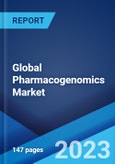The global pharmacogenomics market size reached US$ 7.3 Billion in 2022. Looking forward, the market is expected to reach US$ 12.3 Billion by 2028, exhibiting a growth rate (CAGR) of 9.08% during 2022-2028.
Pharmacogenomics is the study of inherited variations in human genes in response to specific drugs. It utilizes the principles of pharmacology and genomics to develop effective and safe medications that are customized to the genetic makeup of an individual. It involves the use of various technologies, such as polymerase chain reaction (PCR), microarray, deoxyribonucleic acid (DNA) sequencing, mass spectrometry and electrophoresis. The genetic tests performed in pharmacogenomics aid in determining the susceptibility to certain diseases and efficacy of the newly developed drugs. Pharmacogenomics is also widely used in the treatment of various diseases, such as cardiovascular, Alzheimer's, cancer, human immunodeficiency virus and acquired immunodeficiency syndrome (HIV/AIDS) and asthma.
Pharmacogenomics is the study of inherited variations in human genes in response to specific drugs. It utilizes the principles of pharmacology and genomics to develop effective and safe medications that are customized to the genetic makeup of an individual. It involves the use of various technologies, such as polymerase chain reaction (PCR), microarray, deoxyribonucleic acid (DNA) sequencing, mass spectrometry and electrophoresis. The genetic tests performed in pharmacogenomics aid in determining the susceptibility to certain diseases and efficacy of the newly developed drugs. Pharmacogenomics is also widely used in the treatment of various diseases, such as cardiovascular, Alzheimer's, cancer, human immunodeficiency virus and acquired immunodeficiency syndrome (HIV/AIDS) and asthma.
Pharmacogenomics Market Trends
Significant growth in the pharmaceutical industry across the globe is one of the key factors creating a positive outlook for the market. Moreover, the increasing demand for precision medicines with enhanced drug safety is providing a thrust to the growth of the market. With the increasing prevalence of chronic lifestyle diseases, there is widespread adoption of targeted drug therapies with minimal side effects and improved efficacy. In line with this, pharmacogenomics is also extensively used for cancer treatments and anticipating the possible drug responses, resistance, efficacy and toxicity of the chemotherapeutic and targeted immune biologic agents, which is also contributing to the market growth. Additionally, various technological advancements, such as the development of pharmacogenomic biomarker labeling solutions, are acting as other growth-inducing factors. They aid in minimizing the risks of avoidable adverse drug reactions (ADRs) in the body and improve clinical outcomes. Other factors, including extensive research and development (R&D) activities, along with significant improvements in the healthcare infrastructure, are anticipated to drive the market toward growth.Key Market Segmentation
This research provides an analysis of the key trends in each sub-segment of the global pharmacogenomics market report, along with forecasts at the global, regional and country level from 2023-2028. The report has categorized the market based on technology, application and end user.Breakup by Technology:
- Polymerase Chain Reaction
- Microarray
- DNA Sequencing
- Mass Spectrometry
- Electrophoresis
Breakup by Application:
- Oncology
- Infectious Diseases
- Cardiovascular Diseases
- Neurological Diseases
- Psychiatry
- Pain Management
Breakup by End User:
- Hospitals and Clinics
- Academic and Research Institutes
Breakup by Region:
- North America
- United States
- Canada
- Asia-Pacific
- China
- Japan
- India
- South Korea
- Australia
- Indonesia
- Europe
- Germany
- France
- United Kingdom
- Italy
- Spain
- Russia
- Latin America
- Brazil
- Mexico
- Middle East and Africa
Competitive Landscape
The competitive landscape of the industry has also been examined along with the profiles of the key players being Abbott Laboratories, AstraZeneca plc, Bayer AG, Becton Dickinson and Company, Bio-Rad Laboratories Inc., F. Hoffmann-La Roche AG, GlaxoSmithKline plc, Illumina Inc., Johnson & Johnson, Merck KGaA, Myriad Genetics Inc., Qiagen N.V. and Thermo Fisher Scientific Inc.Key Questions Answered in This Report:
- How has the global pharmacogenomics market performed so far and how will it perform in the coming years?
- What has been the impact of COVID-19 on the global pharmacogenomics market?
- What are the key regional markets?
- What is the breakup of the market based on the technology?
- What is the breakup of the market based on the application?
- What is the breakup of the market based on the end user?
- What are the various stages in the value chain of the industry?
- What are the key driving factors and challenges in the industry?
- What is the structure of the global pharmacogenomics market and who are the key players?
- What is the degree of competition in the industry?
Table of Contents
1 Preface3 Executive Summary11 Value Chain Analysis13 Price Analysis
2 Scope and Methodology
4 Introduction
5 Global Pharmacogenomics Market
6 Market Breakup by Technology
7 Market Breakup by Application
8 Market Breakup by End User
9 Market Breakup by Region
10 SWOT Analysis
12 Porters Five Forces Analysis
14 Competitive Landscape
Companies Mentioned
- Abbott Laboratories
- AstraZeneca plc
- Bayer AG
- Becton Dickinson and Company
- Bio-Rad Laboratories Inc.
- F. Hoffmann-La Roche AG
- GlaxoSmithKline plc
- Illumina Inc.
- Johnson & Johnson
- Merck KGaA
- Myriad Genetics Inc.
- Qiagen N.V.
- Thermo Fisher Scientific Inc.
Methodology

LOADING...
Table Information
| Report Attribute | Details |
|---|---|
| No. of Pages | 147 |
| Published | November 2023 |
| Forecast Period | 2022 - 2028 |
| Estimated Market Value ( USD | $ 7.3 Billion |
| Forecasted Market Value ( USD | $ 12.3 Billion |
| Compound Annual Growth Rate | 9.1% |
| Regions Covered | Global |
| No. of Companies Mentioned | 13 |









